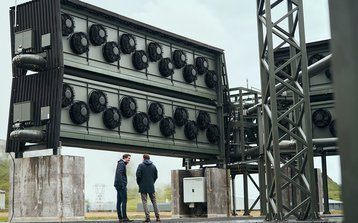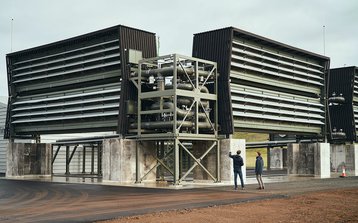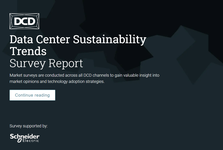Carbon-capture startup Climeworks has opened the world's largest direct air carbon dioxide capture and storage system (CCS) in Iceland. The plant will take carbon dioxide from the air and permanently turn it into stone underground.
The $15 million Orca plant is the size of two shipping containers, and sucks CO2 out of the air to be pumped deep underground and mineralized for long-term storage. The first industrial scale carbon capture and storage plant, Orca cost more than $10 million and can capture 4,000 tons of carbon dioxide a year. This amounts to the equivalent of 250 US citizens, at a cost of around $1200 per ton of CO2 removed. While this cost and capacity is still far less than the world needs, Climeworks says these figures will be improved, making carbon capture affordable and useful within a few years.
$1200 per ton of CO2
The United Nation’s Intergovernmental Panel on Climate Change announced in August that the world has to reduce emissions and remove existing atmospheric greenhouse gases to avoid runaway global warming. Carbon capture and storage has long been a goal, but prototypes have been expensive and small-scale.
Swiss-based Climeworks started in 2017 with a demonstrator at Hinwil near Zurich, before shifting its attention to Iceland where cheap renewable electricity is available and geothermal plants provide access to underground storage for the carbon.
Fans suck huge amounts of air into Orca, located next to ON Power’s Hellisheiði geothermal power plant. Chemicals react with the CO2, leaving nitrogen, oxygen and other gases to return to the atmosphere. The chemical filters are then heated to release the CO2, and Climework's Icelandic partner Carbfix dissolves it in water, and injects it into basaltic rock 1000m underground. Over two years, the dissolved CO2 crystallizes into a mineral that permanently holds it.
The process is energy-intensive, and would be pointless on many country's electricity supplies, as the energy used would create more emissions than the system stores. However, in Iceland, all electricity is from renewable zero-carbon sources, such as the Hellisheiði geothermal power plant.
As well as its emissions, Orca also involves a lot of embedded carbon in its steel and other materials. However, Climeworks says the amount of steel in the Orca collector units has been cut in half compared with earlier prototypes.
Orca was built in 15 months, beginning in May 2020, and Climeworks says it is a "stepping stone" to bigger things, promising to reproduce it elsewhere, and on larger scales that will bring down the cost. The company plans to build a plant ten times as large in three years, leading to "megaton removal capacity by the second part of this decade."
Climeworks began with the lofty ambition of capturing 300 million tons of CO2 - one percent of annual global CO₂ emissions - by 2025. Bloomberg, reports that the founders discovered it takes longer than that to create a global industry and have drastically cut this goal back: the company plans to capture one 600th of that figure, only 500,000 tons, over a longer deadline, pushed back by five years to 2030.
Climeworks hopes to create a carbon removal market but, according to Bloomberg, the process currently costs around $1200 per ton of carbon removed. If used to offset business travel, then this would add about $3000 to the cost of a return flight between Europe and the West Coast of the USA, which creates some 2.5 tons of CO2 emissions. Bulk purchases can make this cheaper: Bloomberg reports that Bill Gates buys carbon capture at $600 per ton captured and stored.
It's possible to remove carbon more cheaply, for instance by taking it from the smokestacks of polluting industries where the CO2 concentration is higher. However, this can require the use of non-renewable energy sources.
Climeworks hopes to reduce the cost of capture to $200 or $300 a ton by 2030 (so offsetting that transatlantic flight would cost $500 to $750). By the middle of the 2030s, the price could be $100 to $200, bringing it closer to the carbon emissions trading price of around $75 per ton. Emissions trading is a penalty price polluters pay in certain circumstances - but not one linked to actual carbon removal.
"Orca is now a reality and it is a result of concerted efforts from every stakeholder involved," said Christoph Gebald, co-CEO and co-founder of Climeworks. "I want to take this opportunity to convey my gratitude and appreciation to the Government of Iceland, our partners in Iceland, our trusted investors, our corporate clients and pioneers, partners, the media, and our team of Climeworkers."
”With this success, we are prepared to rapidly ramp up our capacity in the next years," said Jan Wurzbacher, co-CEO and co-founder of Climeworks. "Achieving global net-zero emissions is still a long way to go, but with Orca, we believe that Climeworks has taken one significant step closer to achieving that goal.’’
Climeworks has backing from Microsoft's innovation fund and Swiss Re. Much of its revenue comes from corporate customers including Microsoft, Stripe, and Shopify, as well as over 8,000 private individuals.
Other options
Alongside direct carbon capture, other options exist, including the obvious one of using trees or other plants to absorb CO2 in photosynthesis. Microsoft has invested in biomass carbon capture with Ørsted and Aker Carbon Capture in Denmark.
Stockholm Exergi has recently invested in a bio-CCS system alongside its Stockholm Data Parks scheme to use waste data center heat in a district heating system.
Shopify has a deal to capture 10,000 tons with Carbon Engineering However, Carbon Engineering has only built a prototype so far - its megaton extractor is due to open in 2024.





